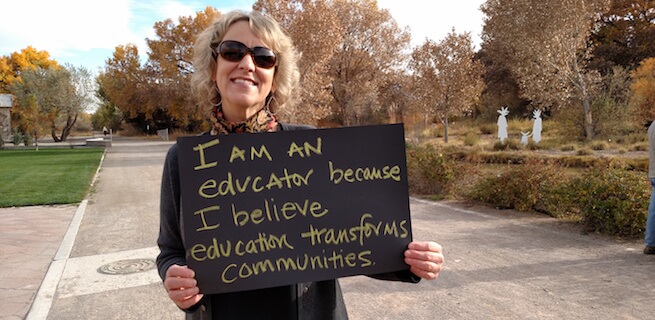Teacher Stress Is Real Because Teaching Well Is Hard: How Inspired and Collaborative Professional Development Can Help
By Sheryl Chard, Sofia Center, Bosque School | May 24, 2018
On my desk I keep a basket of small cards with passages from educators whose life work has shaped my own: Maxine Greene - re-awakening us to the classroom as a site of enormous possibility, bell hooks - reminding us that operating from a place of love is not politically naive, and John Dewey - challenging us to develop “insight into soul action.” That last one always takes my breath away. Over a hundred years ago, Dewey was calling on us to tune in to the inner workings of our students’ unique ways of knowing, the very how of learning and becoming human.
But here’s the thing. It’s May in schools, so let me state the obvious: Stress is at its annual high, a wiry tension of angst and anticipation, and talking very much about insight into soul action would no doubt leave me eating alone in the cafeteria. Instead, I want to talk about the stress that is referenced in nearly every conversation I have with colleagues from schools and organizations across the city. If it were just the stress of May, it might not be so concerning, but forty-six percent of teachers report high levels of daily stress throughout the year, a rate on par only with that reported by nurses and doctors. This should be alarming to all of us.
Most studies of teacher stress, burnout, and attrition report overlapping causes of professional dissatisfaction: the pressures of testing, lack of support, shortage of resources, absence of collegiality, and – sometimes – the pay. But there’s an additional cause of stress that doesn’t seem to show up in the data. It’s this: Teaching well – really well – is a fine art. It’s something larger and more beautiful than the sum of its parts. It requires content and pedagogical expertise, yes, but also relational savvy, cultural competence, intellectual curiosity, a healthy sense of humor, and even “insight into soul action” and love. While your contract may say you’re teaching five sections of high school math, it very likely does not list all of the other capacities that you will need to teach well. And it will not include that on at least one of the 200 days of the school year in one of your decades of teaching, you will -- almost certainly -- be the primary person responsible for the very survival of one of your students. Nobody’s contract says that.
So, yes, there’s stress.
There’s no one fix that will alleviate the aggregated causes of teacher stress. Some causes are so complicated they will require community- and culture-wide revolutions enacted simultaneously in individual classrooms and across systems. And to all the educators doing this revolutionary work, a deep bow of gratitude. But to address the stresses that stem from the inherent complexity of teaching well and being immersed in the lives of young people, there is one immediate, tangible, and highly doable thing we can offer teachers.
It’s this: Design relevant, inspired, community-driven, and intellectually challenging professional learning opportunities that are commensurate with the nuanced demands of teaching well. Place teachers at the center of this learning. Create authentic community. Shine light on their expertise. Fuel their curiosity. Challenge them. Ask them what they want and need. Share resources. Read deeply together. Listen to one another’s wildly diverse experiences. Take this learning back to the classroom. Iterate.
It’s not news that top-down training and one-shot conference experiences have limited impact on teaching practice and student learning. They can certainly effect change when embedded thoughtfully in the ongoing collective work of a school, but alone they fall short. And, worse, when they miss the mark, they exacerbate teachers’ stress.
However, I’ve witnessed what’s possible when educators convene to share expertise and explore complex ideas. It’s powerful, for example, when teachers themselves design strategies to address gender inequities through their math or social studies lessons; it matters that a teacher working in the detention center is rejuvenated through professional development and can share that renewed passion with his students; it empowers teachers when they can develop a reflective practice that allows them to look at their teaching through a critical lens; it changes the lives of students when teachers do the essential, lifelong work of becoming anti-racist educators; and it shifts the whole system when teachers are reminded by one another that they can act with collective agency.
Teaching well is transformative, full of hope, and resonant with joy. It is also stressful. And while much of what needs to change will require an extraordinary combination of small acts of love and large acts of justice, we can begin by inviting teachers into vibrant learning spaces that convey our deep understanding that their work is complex and nuanced; that they carry unique, culturally-specific knowledge, and local wisdom; that teaching is the homeground of possibility; and that their work is critical to our collective future. This alone will go a long way toward limiting stress to the month of May, leaving the rest of the year for the heart of the work.
Sheryl Chard is the founding director of the Sofia Center for Professional Development at Bosque School in Albuquerque, New Mexico. Please visit the Sofia Center website for information about ongoing professional development offerings for teachers, school leaders, and community educators. Since opening its doors in 2013, the Sofia Center has welcomed educators from over 200 schools and organizations. We would love for you to join us.


